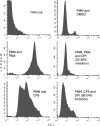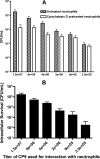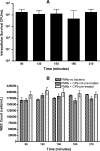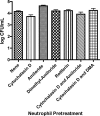Extraintestinal pathogenic Escherichia coli survives within neutrophils
- PMID: 17296761
- PMCID: PMC1932911
- DOI: 10.1128/IAI.01095-06
Extraintestinal pathogenic Escherichia coli survives within neutrophils
Abstract
Extracellular pathogenic Escherichia coli (ExPEC) strains are common causes of a variety of clinical syndromes, including urinary tract infections, abdominal infections, nosocomial pneumonia, neonatal meningitis, and sepsis. ExPEC strains are extracellular bacterial pathogens; therefore, the innate immune response (e.g., professional phagocytes) plays a crucial role in the host defense against them. Studies using the model ExPEC strain CP9 demonstrated that it is relatively resistant to neutrophil-mediated bactericidal activity. Although this could be due to resistance to phagocytosis, the ability of CP9 to survive the intracellular killing mechanisms of neutrophils is another possibility. Using a variation of the intracellular invasion assay, we studied the survival of CP9 within peripheral blood-derived human neutrophils. Our results indicated that CP9 did survive within human neutrophils, but we were unable to demonstrate that intracellular replication occurred. This finding was not unique to CP9, since when a conservative assessment of survival was used, four of six additional ExPEC strains, but not an E. coli laboratory strain, were also capable of survival within neutrophils. Initial studies in which we began to decipher the mechanisms by which CP9 is able to successfully survive intracellular neutrophil-mediated bactericidal activity demonstrated that CP9 was at least partially susceptible to the neutrophil oxidative burst. Therefore, absolute resistance to the oxidative burst is not a mechanism by which ExPEC survives within neutrophils. In addition, electron microscopy studies showed that CP9 appeared to be present in phagosomes within neutrophils. Therefore, avoidance of phagosomal uptake or subsequent escape from the phagosome does not appear to be a mechanism that contributes to CP9's survival. These findings suggest that survival of ExPEC within neutrophils may be an important virulence mechanism.
Figures









Similar articles
-
Extraintestinal pathogenic Escherichia coli (ExPEC) of human and avian origin belonging to sequence type complex 95 (STC95) portray indistinguishable virulence features.Int J Med Microbiol. 2014 Oct;304(7):835-42. doi: 10.1016/j.ijmm.2014.06.009. Epub 2014 Jun 27. Int J Med Microbiol. 2014. PMID: 25037925
-
Bile Salts Regulate Zinc Uptake and Capsule Synthesis in a Mastitis-Associated Extraintestinal Pathogenic Escherichia coli Strain.Infect Immun. 2021 Sep 16;89(10):e0035721. doi: 10.1128/IAI.00357-21. Epub 2021 Jul 6. Infect Immun. 2021. PMID: 34228495 Free PMC article.
-
Extraintestinal pathogenic Escherichia coli.Foodborne Pathog Dis. 2007 Summer;4(2):134-63. doi: 10.1089/fpd.2007.0087. Foodborne Pathog Dis. 2007. PMID: 17600482 Review.
-
Caenorhabditis elegans as a simple model to study phenotypic and genetic virulence determinants of extraintestinal pathogenic Escherichia coli.Microbes Infect. 2007 Feb;9(2):214-23. doi: 10.1016/j.micinf.2006.11.009. Epub 2006 Dec 8. Microbes Infect. 2007. PMID: 17208486
-
What defines extraintestinal pathogenic Escherichia coli?Int J Med Microbiol. 2011 Dec;301(8):642-7. doi: 10.1016/j.ijmm.2011.09.006. Epub 2011 Oct 5. Int J Med Microbiol. 2011. PMID: 21982038 Review.
Cited by
-
Clinical and phenotypic differences between classic and hypervirulent Klebsiella pneumonia: an emerging and under-recognized pathogenic variant.Eur J Clin Microbiol Infect Dis. 2012 Jun;31(6):981-9. doi: 10.1007/s10096-011-1396-6. Epub 2011 Sep 15. Eur J Clin Microbiol Infect Dis. 2012. PMID: 21918907
-
Preconceptual Priming Overrides Susceptibility to Escherichia coli Systemic Infection during Pregnancy.mBio. 2021 Feb 23;12(1):e00002-21. doi: 10.1128/mBio.00002-21. mBio. 2021. PMID: 33622714 Free PMC article.
-
An E. coli display method for characterization of peptide-sensor kinase interactions.Nat Chem Biol. 2023 Apr;19(4):451-459. doi: 10.1038/s41589-022-01207-z. Epub 2022 Dec 8. Nat Chem Biol. 2023. PMID: 36482094 Free PMC article.
-
Escherichia coli O157:H7 survives within human macrophages: global gene expression profile and involvement of the Shiga toxins.Infect Immun. 2008 Nov;76(11):4814-22. doi: 10.1128/IAI.00446-08. Epub 2008 Aug 25. Infect Immun. 2008. PMID: 18725421 Free PMC article.
-
Amniotic fluid neutrophils can phagocytize bacteria: A mechanism for microbial killing in the amniotic cavity.Am J Reprod Immunol. 2017 Oct;78(4):10.1111/aji.12723. doi: 10.1111/aji.12723. Epub 2017 Jul 13. Am J Reprod Immunol. 2017. PMID: 28703488 Free PMC article.
References
-
- Allen, L. A. 2003. Mechanisms of pathogenesis: evasion of killing by polymorphonuclear leukocytes. Microbes Infect. 5:1329-1335. - PubMed
-
- Brinkmann, V., U. Reichard, C. Goosmann, B. Fauler, Y. Uhlemann, D. S. Weiss, Y. Weinrauch, and A. Zychlinsky. 2004. Neutrophil extracellular traps kill bacteria. Science 303:1532-1535. - PubMed
Publication types
MeSH terms
Grants and funding
LinkOut - more resources
Full Text Sources
Medical

